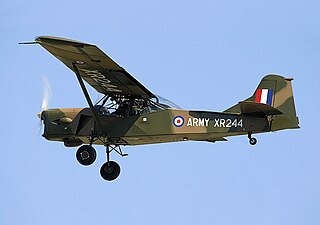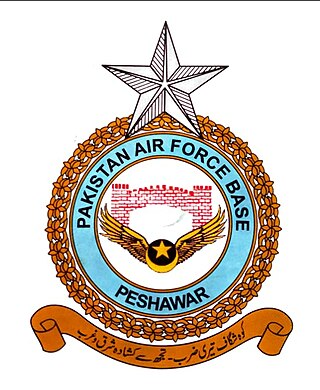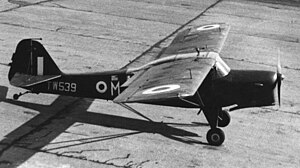
Auster Aircraft Limited was a British aircraft manufacturer from 1938 to 1961.

The English Electric Canberra is a British first-generation, jet-powered medium bomber. It was developed by English Electric during the mid- to late 1940s in response to a 1944 Air Ministry requirement for a successor to the wartime de Havilland Mosquito fast bomber. Among the performance requirements for the type was an outstanding high-altitude bombing capability and high speed. These were partly accomplished by making use of newly developed jet-propulsion technology. When the Canberra was introduced to service with the Royal Air Force (RAF), the type's first operator, in May 1951, it became the service's first jet-powered bomber.

The Avro Shackleton is a British long-range maritime patrol aircraft (MPA) which was used by the Royal Air Force (RAF) and the South African Air Force (SAAF). It was developed by Avro from the Avro Lincoln bomber, which itself had been a development of the famous wartime Avro Lancaster bomber.

Joint Helicopter Command Flying Station Aldergrove, also known as simply JHC FS Aldergrove, is a British military base located 4.4 miles (7.1 km) south of Antrim, Northern Ireland and 18 miles (29 km) northwest of Belfast, and adjoins Belfast International Airport. It is sometimes referred to simply as Aldergrove which is the name of a nearby hamlet.

Royal Air Force Laarbruch, more commonly known as RAF Laarbruch ICAO EDUL was a Royal Air Force station, a military airfield, located in Germany on its border with the Netherlands. The Station's motto was Eine feste Burg.

Ein Shemer Airfield also called Hadera East is an Israeli Air Force (IAF) base in northern Israel, located approximately 6 km east of Hadera in the Haifa District, named after the nearby kibbutz Ein Shemer. It houses no fighter jets or helicopters but UAVs for testing and a defense missile battery with long-range radar.

Royal Air Force Bottisham or more simply RAF Bottisham is a former Royal Air Force station located 5 miles (8 km) east of Cambridge, Cambridgeshire, England.
No. 666 Squadron was a Royal Air Force air observation post (AOP) squadron associated with the Canadian 1st Army and later part of the Royal Auxiliary Air Force. Numbers 651 to 663 Squadron of the RAF were air observation post units working closely with British Army units in artillery spotting and liaison. A further three of these squadrons, 664–666, were manned with Canadian personnel. Their duties and squadron numbers were transferred to the Army with the formation of the Army Air Corps on 1 September 1957

Army Aviation Centre (AAC) Middle Wallop is a British Army airfield located near the Hampshire village of Middle Wallop, used for Army Air Corps training. The base hosts 2 (Training) Regiment AAC and 7 (Training) Regiment AAC under the umbrella of the Army Aviation Centre. 2 (Training) Regiment performs ground training; 7 (Training) Regiment trains aircrew on AAC aircraft after they complete basic training at RAF Shawbury.

The Taylorcraft Auster was a British military liaison and observation aircraft produced by the Taylorcraft Aeroplanes (England) Limited company during the Second World War.

The Auster J/1 Autocrat was a 1940s British single-engined three-seat high-wing touring monoplane built by Auster Aircraft Limited at Rearsby, Leicestershire.

The Auster AOP.9 was a British military air observation aircraft produced by Auster Aircraft Limited to replace the Auster AOP.6.

Pakistan Air Force Base, Peshawar is an airbase of the Pakistan Air Force (PAF) located in Peshawar, Khyber Pakhtunkhwa, Pakistan. It is the operational site of the PAF's Northern Air Command, located to the east of Bacha Khan International Airport, which is shared by both civil aviation flights and military flights.
No. 663 Squadron was an air observation post (AOP) unit, manned with Polish Army personnel, which was officially formed in Italy on 14 August 1944. Numbers 651 to 663 Squadrons were air observation post units working closely with Army units in artillery spotting and liaison. A further three of these squadrons, 664–666, were manned with Canadian personnel. Their duties and squadron numbers were transferred to the Army with the formation of the Army Air Corps on 1 September 1957.
No. 661 Squadron was a Royal Air Force air observation post squadron associated with the Canadian 1st Army and later part of the Royal Auxiliary Air Force. Numbers 651 to 663 Squadrons of the RAF were air observation post units working closely with Army units in artillery spotting and liaison. A further three of these squadrons, 664–666, were manned with Canadian personnel. Their duties and squadron numbers were transferred to the Army with the formation of the Army Air Corps on 1 September 1957.

No. 662 Squadron was a Royal Air Force air observation post squadron associated with the 21st Army Group and later part of the Royal Auxiliary Air Force. Numbers 651 to 663 Squadrons of the RAF were air observation post units working closely with Army units in artillery spotting and liaison. A further three of these squadrons, 664–666, were manned with Canadian personnel. Their duties and squadron numbers were transferred to the Army with the formation of the Army Air Corps on 1 September 1957. It is now an Apache Helicopter Squadron.
No. 665 "Air Observation Post" Squadron, RCAF was formed in England during the Second World War. It was manned principally by Royal Canadian Artillery (RCA) and Royal Canadian Air Force (RCAF) personnel, with select British artillery pilots briefly seconded to assist in squadron formation. Numbers 651 to 663 Squadrons of the RAF were air observation post units working closely with Army units in artillery spotting and liaison. A further three of these squadrons – Nos. 664, 665 and 666 – were RCAF AOP squadrons manned by Canadian and British personnel.
No. 664 Squadron was a Royal Air Force air observation post squadron associated with the Canadian 1st Army and later part of the Royal Auxiliary Air Force. Numbers 651 to 663 Squadrons of the RAF were air observation post units working closely with Army units in artillery spotting and liaison. A further three of these squadrons, 664–666, were manned with Canadian personnel. Their duties and squadron numbers were transferred to the Army with the formation of the Army Air Corps on 1 September 1957.

An air observation post (AOP) is an aeroplane or helicopter used in the role of artillery spotter by the British Army and Commonwealth forces. In this role, either the pilot of the aircraft or another crew member acts as an observer watching for targets on the ground, and/or as a forward observation officer directing the fire, by radio, of artillery on the ground.
RAF Westley is a former Royal Air Force satellite airfield located to the west of Bury St Edmunds, Suffolk, England, between 1938 and 1946. It was established by the Straight Corporation which set up the West Suffolk Aero Club in May 1938, before the airfield was taken over by the RAF Volunteer Reserve.




















